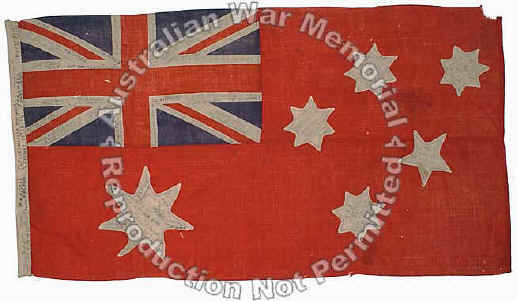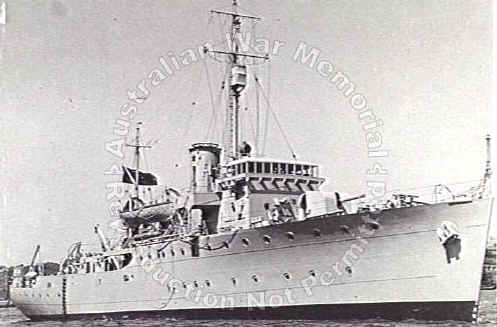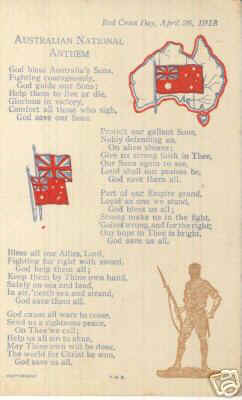 |
|
|||
|
Australia's Forgotten Flag. The Red Ensign |
|
Because the Blue Ensign (Commonwealth
Ensign) was the official
flag and it's use by ordinary citizens was discouraged many people from
the Attorney General down used the Red Ensign as a de-facto Civil Flag.
It was not strictly correct, but it happened at every level of the
community.
In 1914 all three flags, the British Union Flag, the Federal Flag and the Civil flag were all used. Some of the best indications of how the soldiers themselves thought of the flags is in the ensigns that are on display at the Australian War Memorial and the RAAF Museum.
|
Sub category index
|
 |
| Opening of Federal Parliament at Canberra, 9 May 1927 Note that the Australian flags are Red Ensigns. There is some dispute as to whether this is accurate. Septimus Power (1878–1951) Historic Memorials Collection, Canberra. Courtesy of the Parliament House Art Collection, Department of Parliamentary Services, Canberra ACT. |
|
|
| This 1916 "souvenir" tea towel depicting scenes from the Dardanelles clearly shows an Australian Red Ensign. |
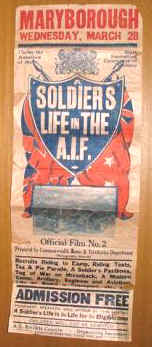 |
|
|
Maryborough Victoria, not Queensland. |
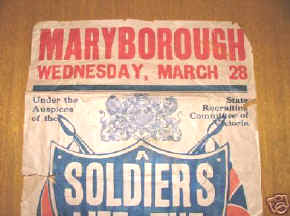 |
 |
|
This group of images show the Red Ensign being used alongside the Union Jack in AIF recruiting. |
|
 |
Cloth
embroidered with a King's crown with the British and Australian (Red
Ensign) flags on either side. The
crown is surrounded by a green wreath and two scrolls, one at the top
and one at the bottom.
These scrolls contain the words 'FOR ENGLAND HOME AND BEAUTY/AUSTRALIA WILL BE THERE'. Associated with 6311 Private Alfred Samuel Smart. Smart enlisted on 6 April 1916 and served with 19 Battalion. He returned to Australia on 30 January 1918. |
|
|
|
| Title: Autographed
Australian red ensign carried by NX17521 Corporal W E Watson as a POW in
Greece, and later in New Guinea Maker: S Calder Ltd, Sydney Object type:
Flag Place made: Sydney Date made: 1939 Physical description: Wool
bunting; canvas; hemp Summary: NX17521 Corporal William Edward Watson
served with 6 Division AAOC and 7 Division Provost Company. He was
captured on Crete on 1 June 1941, shipped to Athens and then Salonika.
He escaped from Salonika on 29 June 1941, joined up with other POW
escapees and hid in the Greek mountains until 1942, when he successfully
escaped by boat to Turkey on 5 May 1942. Watson was discharged medically
unfit on his return to Australia and subsequently joined the American
Small Boats Division, serving in New Guinea. He was awarded the Military
Medal for 'courage and perseverance in escapes from POW camps'.
In 1914, Watson's father, who had served with a British Regiment before emigrating to Australia, was farewelled by the Australian Attorney General W M 'Billy' Hughes (later Prime Minister) as he returned to Britain with other Imperial Reservists for service in the First World War. Hughes presented Watson with an Australian red ensign which he carried with him throughout the war. Watson claimed that it was the first Australian flag to be flown in France during the war, and on his safe return to Australia presented it to the Australian War Museum (later War Memorial) for display. His son, W E Watson, asked that the flag be returned to him to carry during his service in the Second World War, but his request was refused. Watson then applied to Billy Hughes, who was again Attorney General, for another flag, and this red ensign is the one that Hughes sent to him, together with the words, 'I would like to say that it is my earnest prayer that you will be spared to carry it triumphantly throughout this present conflict. You will bear it through lands where the valorous tradition of the A.I.F. is a by-word. I know that this glorious heritage will be safe in the keeping of Australia's sons of the 2nd A.I.F.'. Watson junior carried it throughout his service in Egypt, concealed it during his captivity in Crete and Greece, and again carried it during his service in New Guinea |
|
|
|
|
| This ensign was presented
to the Imperial Reservists who left Australia in 1914, by the Honourable
W M 'Billy' Hughes, then Attorney General and later Prime Minister, and
personally handed to Corporal Edward Dawson Watson of the East
Lancashire Regiment. The Imperial Reservists were men who had recently
served with a British Regiment before emigrating to Australia. On the
outbreak of the First World War they were recalled to serve with their
old units and sailed in the first troop convoy to leave Australia.
Dawson took the flag to England and France, and carried it during the
retreat from Mons.
After a spell in England he took it back to France in March 1917. Watson remained in France until the German Advance in March 1918, when he was wounded. He brought the flag back to Australia in 1919. Watson claimed that it was the was the first Australian flag to fly in France during the First World War, however the NSW Volunteer Ambulance Unit may also have carried one in France in 1914. Watson presented the flag to the Australian War Museum (later War Memorial) in 1925 on the condition that it be returned to him for each year's Anzac Day march. He died shortly after Anzac Day in 1934 and the flag has been part of the Memorial's permanent collection since this date. |
|
|
|
|
| William Pearson Tewksbury,
a successful Melbourne businessman, conceived the idea of raising funds
for wounded Australian soldiers by raffling a flag autographed by the
world's most famous men, including national and war leaders, Field
Marshal Lord Kitchener, Prime Minister W M Hughes and General Monash.
The flag was sent around the world to obtain the signatures and 20,000
pounds was raised from the raffle. The flag was advertised as the
'Kitchener Flag'. It was won by a retired seaman who sold it to Edward
Solomon, a Melbourne philanthropist and collector, who had already
purchased other autographed flags at fund raising auctions for the war
effort. Solomon later presented his entire autographed flag collection,
which he had acquired during the First World War, to the Australian War
Memorial. |
|
 |
|
|
Printed cotton Australian red ensign
signed in black from 'The One Woman / One Recruit League'. Union Jack
has recipient's name, '25/14' and 'AU-REVOIR' applied in ink. Each of
the five stars of the Southern Cross are also signed: 'Bon Voyage', 'A
Speedy Return', 'To Dear Australia', 'May Victory be Yours', ' We are
proud of you'. The six pointed star is signed: 'As you carry this flag
into / far distant land / Remember kind thoughts / blessings, good
wishes / and God speed follow You / From / The One WOMAN / One RECRUIT
League'.
7441 Private Percy Vernon Barr, a labourer of Mirboo North, Victoria, enlisted on 25 June 1917 at age 30 and embarked for overseas service aboard HMAT Nestor on 21 November 1917 as a member of the 25th reinforcements of the 14th Battalion. He was wounded in France on 18 September 1918 and returned to Australia on 2 February 1919. This Red Ensign was presented to him upon his embarkation by an anonymous donor simply signed as 'The One Woman One Recruit League', for which no information exists. Speculatively, the 'The One Woman One Recruit League' may have been his wife, Clara. Percy Barr carried this flag with him during his active service in France and his return to Australia. It remained a significant relic for his family. His grandson Ross recalls that it was used during the Royal visit to Australia in 1954, when he and some mates travelled some 60 km from Korumburra to Warragul in the back of a ute to see the Queen, waving this flag, which was wired to a rough pole. The subsequent repairs were made by Ross's mother on a sewing machine. |
|
|
|
|
|
1917 postcard sent from UK to Australia |
|
|
|
|
|
Murray's "V" for Victory Assorted Toffees, circa 1943. |
Allies Day badge circa 1918. Note the Red Ensign centre right, top. |
|
|
|
| Framed moulded-paper
bulldog mascot superimposed on an Australian red ensign : Private P J
Bradshaw, 6 Battalion, AIF.
Associated with 713 Private Percival James Bradshaw, 6 Battalion AIF. He enlisted on 24 February 1917, served on the Western Front, and returned to Australia on 13 July 1919. He acquired the mascot from the battalion sergeants' mess when he was an orderly. |
|
|
|
|
| NX55941 Coproral Edward Gordon Patrick 'Pat' Sullivan was born in Deniliquin, NSW, in 1902. He enlisted for service in the Second Word War on 1 July 1940 and was assigned to 2/18 Battalion. The battalion sailed to Malaya with 8 Division and subsequently took part in the fight against the Japanese before the fall of Singapore in February 1942, when all the survivors were taken prisoner. Sullivan quickly realised that he would need a hobby to occupy his mind rather than giving way to depression. A friend from 2/9 Field Ambulance gave him a bag of embroidery cottons he had found during the fighting in Singapore. Another prisoner showed him some basic embroidery stitches and helped him with his first attempts at needlework. All the designs on his embroideries were his own work. The Commonwealth Bank cash bag came from the paymaster of 2/18 Battalion. Sullivan intended this bag to be an embroiderer's work bag after he had completed it. Work on the bag took several months to complete. A cushion cover and a tablecloth were the first works to be finished. Sullivan had a single needle which he carried in an improvised bamboo case. His embroidery was carried out in spare time when he was not required to work by the Japanese, both in Changi and on the Burma-Thailand Railway. A British officer intervened when the Japanese attempted to confiscate one of the embroideries Sullivan was working on, and fellow Australians also helped to conceal his work during other Japanese searches. | |
|
|
|
| NX3048 Sergeant Richard Sydney Turner was born in Sydney in 1916. He enlisted on 28 October 1939 and served with 6 Division Supply Column, Australian Army Service Corps. After service in Africa he was captured by the Germans near Megara during the Greek campaign in June 1941, but escaped from the train taking him to Germany. He was initially sheltered by the Greeks but this became too dangerous when Italian troops offered large rewards for the capture of Allied soldiers and threatened to shoot anyone harbouring them. Turner and a companion hid in the mountains south of Thessaly during the winter of 1941-1942. Weak from malnutrition and malaria he was considering of giving himself up when he met Ioannis Kallinikos from the village of Livanatas, who sheltered him for the next year and a half. Turner joined the Greek resistance in the summer of 1943 and led a band of fifty Greek andartes. He later joined the British Military Mission in Greece (Force 133), which operated behind German lines. He was awarded the Military Medal for his endurance and service in Greece. Turner was killed by Greek communist insurgents, during the civil war which broke out in Greece following the withdrawal of the Axis forces, on 17 December 1944 while in a truck on his way to Athens airport to be repatriated to Australia. Turner carried this small flag throughout his service in North Africa and Greece. | |
|
|
|
| PORT PHILLIP BAY, VIC. 1953. Starboard beam view of the former destroyer HMAS Quadrant (fo1) after her conversion to an anti submarine frigate. Externally her destroyer origins are indicated only by her funnel and hull as all superstructures above the upper deck has been replaced. The ship's new armament consists of a twin 40 mm Bofors mark 5 AA mounting forward and 4 inch mark 16 guns in a twin mark 19 mounting aft. Note the launching rails for flare rockets fitted to the side of the mounting. The guns are controlled by the close range blind fire director sited just forward of the 4 inch mounting. A squid anti submarine mortar is fitted aft and is a distinguishing feature of this vessel, the remainder of the class having the longer barreled limbo. A type 277 height finding radar is fitted just above the bridge. Type 293q air surface search and type 974 navigation radars are fitted to the foremast. The ship has not yet been commissioned and is flying the red ensign. She is also not fully fitted out, missing her mainmast. (Naval historical collection) | |
|
|
|
| SYDNEY, NSW. 1941-09. Starboard bow view of the corvette HMAS Warrnambool. She is not yet commissioned and consequently flies the red ensign. She is armed with a 4 inch bl mark ix gun on a cpi mounting forward. No close range armament has yet been fitted. Note the kite/otters and floats of her oropesa minesweeping equipment on the stern. (Naval historical collection) | |
|
|




